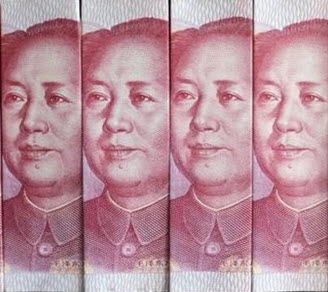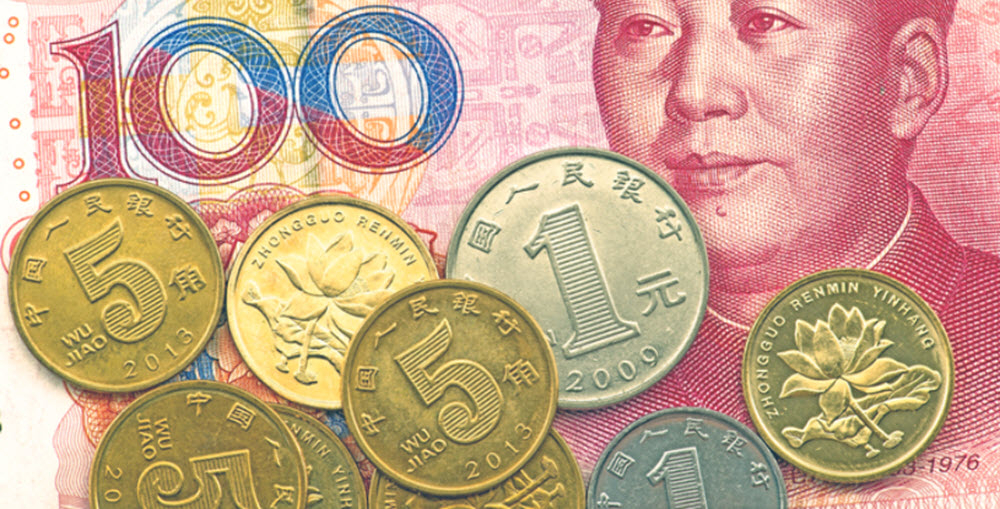In this article:
The renminbi (CNY) is the currency of the People’s Republic of China. The basic unit of the renminbi is the yuan. In everyday speech, the terms yuan and Chinese yuan are commonly used as alternative names for the currency, especially in international contexts.
The Renminbi is on the top-10 list of the world’s most frequently traded currencies. Data from the year 2018 show it to be on #8.
Most traded currencies in 2018:
| Position | Currency |
| 1 | United States dollar |
| 2 | Euro |
| 3 | Japanese yen |
| 4 | Pound sterling |
| 5 | Australian dollar |
| 6 | Canadian dollar |
| 7 | Swiss franc |
| 8 | Renminbi / Chinese yuan |
| 9 | Swedish krona |
| 10 | Mexican peso |
In the year 2018, the USD/CNY currency pair was the sixth most commonly traded pair on the FX market.
Most traded currency pairs in 2018:
-
EUR/USD
-
USD/JPY
-
GBP/USD
-
AUD/USD
-
USD/CAD
-
USD/CNY (USD/RMB)
-
USD/CHF
-
EUR/GBP
-
USD/MXN
-
USD/SGD
The renminbi was pegged to the United States dollar until 2005. Since then, the exchange rate has been more flexible, although Chinese authorities still take action to keep it within a specific range in relation to a basket of trade-weighted foreign currencies. According to statements made by the Chinese government, the plan is to gradually increase the exchange rate’s flexibility.
In February 2015, the RMB became the second-most used currency in the world for trade and services.
On 1 October 2016, the renminbi became the first emergin market currency to be included in the International Monetary Fund’s special drawing rights basket. The basket now consists of 41.73% USD, 30.93% EUR, 10.92% RMB, 8.33% JPY, and 8.09% GBP.
Where is the Renminbi used?
The Renminbi is the official currency in the People’s Republic of China.
The official currency for Hong Kong is the Hong Kong Dollar, but the Renminbi is widely circulated as well. (In Hong Kong, it is even possible to have a bank account in Renminbi and withdraw Renminbi bills from ATMs. ) The situation is similar in Macau, where the Macanese pataca is the official currency but the Renminbi is widely accepted as well.
There are many countries adjacent to China where the Renminbi is used inofficially alongside the official currecy, especially in the border regions. This is for instance the case in Mongolia, Vietnam, Laos, Cambodia, Myanmar/Burma, and Nepal.
In North Korea, there are many stores that accept payments in USD, EUR and Renminbi, but where you will almost always get your change back in Renminbi only since that currency is more commonly available.
In Zimbabwe, the Renminbi is one of several foregn currencies that have been utilized since the national currency was abolished in 2009.

Short facts about the Renminbi
Name of the currency: Rénmínbì
ISO 4217 abbreviation: CNY
Alternative abbreviation: RMB
ISO 4217 numerical code: 156
Sign: ¥ or CN¥
Name of the base unit: Yuán (formal:圆 / informal: 元)
1 yuán = 10 jiǎo
1 yuán = 100 fēn
Nickname: Grandpa Mao
Central bank: People’s Bank of China
Monetary policy
The renminbi is issued by the People’s Bank of China. This is the central bank of the People’s Republik of China, and it is responsible for carrying out monetary policy and regulating financial institutions in mainland China, as determined by People’s Bank Law and Commercial Bank Law. The bank is a department of the State Council, but possesses a fairly high degree of independence – especially by Chinese standards. Since July 2017, the People’s Bank of China has had the largest financial asset holdings of any central bank in the world.
Until 2005, the renminbi was pegged to the United States dollar. As China pursued increased exports, the renminbi was devalued to boost the competitiveness of Chinese products on the international market.
Since 2006, the renminbi exchange rate has been allowed to float a bit, but only within a narrow spectrum around a fixed base rate determined by the Chinese authorities based on a trade-weighted basket of foreign currencies.
For a while, the renminbi was considered to be extremely undervalued against its purchasing power parity, but by late 2012 this alleged undervaluation was down to less than 10%, due to a combination of appreciation actions by the Chinese government and quantitative easing carried out by several central banks and the United States Federal Reserve System.
Internationalization of the RMB
Since the late noughties, the Chinese government has succefully sought to internationalize the Renminbi. In 2009, China established the dim sum bond market and expanded the Cross-Border Trade RMB Settlement Pilot Project, thus establishing more pools of offshore RMB liquidity.
In 2011, China established the Renminbi Qualified Foreign Institutional Investor (RQFII) program, a program that allows approved foreign investors to invest directly in Mainland China’s bond and equity markets. The program is an important part of China’s work to gradually loose their capital controls. The current RQFII relevant jurisdiction applies to financial organizations registered in Australia, Canada, Hong Kong, France, Germany, Luxembourg, Singapore, South Korea, Switzerland, the United Kingdom, and the United States.
The Shanghai-Hong Kong Stock Connect was launched in late 2014, and that same year, Hong Kong removed its conversion limit of 20,000 RMB per day for its residents.
This article was last updated on: August 8, 2019
